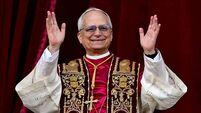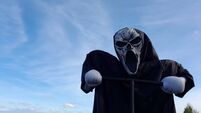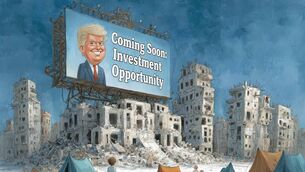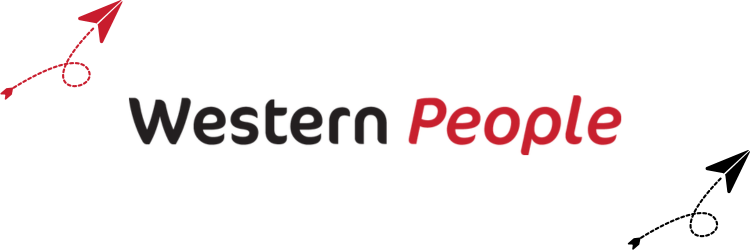Pope Francis laid a path for positive change
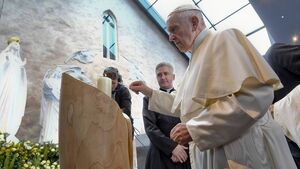
The rector of Knock Shrine, Fr Richard Gibbons, looks on as Pope Francis lights a candle during his visit to Knock on August 26, 2018. Picture: Ciro Fusco/AFP via Getty Images
For those of us born in the late 1970s and early 1980s, it was beginning to feel like there would only ever be one pope.
Pope John Paul II was such a constant in our upbringing in a very different Ireland. Many homes had framed photos of him. At school and in church, he was a borderline deity.
His papacy lasted almost 27 years, the third longest in history, including St Peter, the very first pope.
So for those of us in our early 40s now (43 is early 40s, isn’t it?), we were well into adulthood with this one man as the head of the church that had such a hold on the Ireland we grew up in but so much had changed by the time of his passing in 2005.
To our young minds, he appeared to be a warm man, like a gentle grandfather. His reverence in the middle Ireland of our childhood was cemented by the famous visit here in 1979, including an incredible visit to the Marian Shrine at Knock, which drew 400,000 people to east Mayo.
Any time you met anyone called John Paul, you were able to age them instantly – they were almost certainly born in 1979 and christened after the Pope.
So long was his papacy that I know one friend who was in a long-term relationship and coming under pressure to pop the question. The length of the relationship was described brilliantly by one wit as ‘13 Eurovisions, four World Cups’ and, the kicker, ‘three popes’.
Having only known one pope for so long, three popes seemed like a lifetime to our generation. Thankfully, the engagement and marriage arrived long before a fourth pope.
The crowds that greeted Pope John Paul II in 1979 stood in stark contrast to the far more modest numbers who turned out to welcome Pope Francis in 2018 and told the story of the sea-change in Irish approaches towards the Catholic Church in the intervening 40-odd years.
While Pope John Paul II’s emphasis on religious freedom and strong role in the decline of communism in Eastern Europe stand in his favour, he was a conservative pope whose outlook was often at odds with modern society. Indeed, even within the church itself, he was conservative and someone who sought to rein in certain aspects of the Second Vatican Council.
More presciently, as far as Ireland is concerned, he was head of a church that failed miserably to protect children from horrific sexual abuse carried out by priests and members of Catholic religious orders.
While he was unequivocal in 2002 that "there is no place in the priesthood and religious life for those who would harm the young", the counterpoint to that is that victims of abuse continuously met resistance from a supposed Christian church more concerned with self-protection than admitting its sins and seeking forgiveness.
Abuse scandal after scandal from the 1990s onwards saw the church’s star in Ireland diminish greatly. It was not just the acts themselves but how known paedophile priests were transferred from parish to parish to continue their depravity as church leaders turned a blind eye.
It was very hard for those of us who grew up in the church to maintain faith in it.
My generation does not attend Mass in anywhere near the numbers our parents’ generation did. There are many reasons for that but the abuse scandals are a pivotal factor.
John Paul II’s successor, Pope Benedict XVI, was similarly of a conservative outlook at a time when the church really needed someone far more radical to respond to the modern world and the struggles the church was facing, many of them self-inflicted.
Into the breach left by Benedict’s retirement in 2013 went Argentinian Jorge Mario Bergoglio. Straight away, you got the sense that here was a leader of the Catholic Church that more people inside and outside the Church could identify with.
By eschewing the papal palace for very modest accommodation at a Vatican guesthouse, here was a pope who had no interest in the trappings of the office. Indeed, when he was in Mayo in 2018, his vehicle of choice was a Skoda Rapid. I never thought I’d feel as highfalutin in my Octavia.
It was the start of a very pointed and clear effort to remove elitism from the leadership of the church. In 2015, he moved to stress the importance of action on climate change, preaching the significance of our stewardship of our lands.
Far beyond his two predecessors, Pope Francis championed the rights of the poor, marginalised and vulnerable, including immigrants and those fleeing war and danger. There was nothing hypocritical about it either because he lived such a simple life, dying with less than €100 to his name, forgoing his papal salary from day one.
As Fr Brendan Hoban has articulated, Pope Francis ushered in a far more open and inclusive church for all its constituent parts, creating a sense of belonging at odds with his predecessors.
By papal standards, he was a radical when it came to social issues. While many might argue he did not go far enough on many issues, the reality is he went further than anyone could have expected and paved the way for a successor to, hopefully, continue on that journey.
The great fear, of course, is that conservative elements within the church will regain the reins and try to scale back any such progress.
There was no doubt that when visiting Ireland in 2018, Pope Francis was arriving to a people far more hostile to his church than John Paul II’s adoring crowds of 1979.
But it was also clear that Pope Francis was the right pope to make the visit, to express the sorrow of his church and for people, in the main, to accept it as heartfelt and genuine from an evidently decent and humble man.
No more than politicians in Ireland, you were never fully sure how much Pope Francis was in charge of the Vatican, where the Roman Curia wields considerable power. But on his passing, he left not just the world but a church in a better place. Where it goes from now is someone else’s responsibility but Jorge Mario Bergoglio has sown the seeds of positive change. And not before time.
